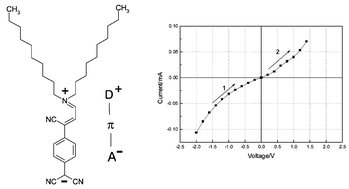Didecylammonium tricyanoquinodimethanide, a zwitterionic molecule of the type D+–π–A−
(where D+
= ammonium, π
= ethylene “bridge”, and A−
= tricyanoquinodimethanide), forms a Pockels–Langmuir monolayer film at the air–water interface. The molecules can be transferred quantitatively as a Langmuir–Blodgett (LB) monolayer onto a gold surface. Using the “cold-gold” evaporation technique, a set of several macroscopic gold electrode pads were evaporated atop the LB monolayer. Pads which had macroscopic defects were electrical short circuits, but across many pads finite electrical currents were observed as a function of applied bias; however, no obvious electrical rectification was found. The monolayer thickness on a gold substrate was measured by XPS to be ∼22 Å. Reflection-absorption infrared spectroscopy (RAIRS) indicates that the molecules have a preferred orientation in the film, but are not well ordered. Angle-resolved X-ray photoelectron spectroscopy (XPS) suggests that many of the molecules are oriented anti-parallel to each other, possibly because dipole–dipole forces favor such an anti-parallel orientation. This latter observation helps to explain why no electrical rectification was found.

You have access to this article
 Please wait while we load your content...
Something went wrong. Try again?
Please wait while we load your content...
Something went wrong. Try again?


 Please wait while we load your content...
Please wait while we load your content...